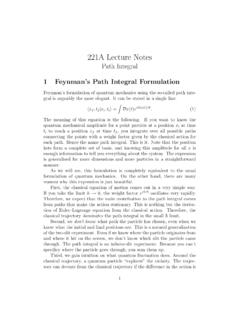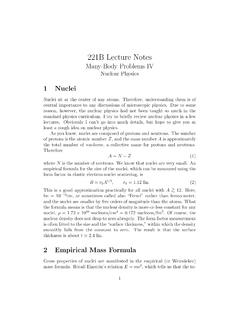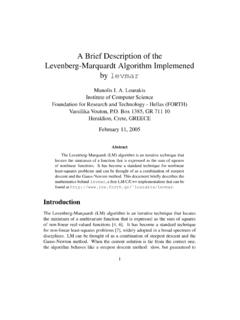Transcription of 221B Lecture Notes - Hitoshi Murayama
1 221b Lecture NotesNotes on Spherical Bessel Functions1 DefinitionsWe would like to solve the free Schr odinger equation h22m[1rd2dr2r l(l+ 1)r2]R(r) = h2k22mR(r).(1)R(r) is the radial wave function (~x) =R(r)Yml( , ). By factoring out h2/2mand defining =kr, we find the equation[1 d2d 2 l(l+ 1) 2+ 1]R( ) = 0.(2)The solutions to this equation are spherical Bessel functions. Due to somereason, I don t see the integral representations I use below in books on math-emtical formulae, but I believe they are behavior at the origin can be studied by power expansion. AssumingR n, and collecting terms of the lowest power in , we getn(n+ 1) l(l+ 1) = 0.
2 (3)There are two solutions,n=lor l 1.(4)The first solution gives a positive power, and hence a regular solution at theorigin, while the second a negative power, and hence a singular solution atthe is easy to check that the following integral representations solve theabove equation Eq. (2):h(1)l( ) = ( /2)ll! i +1ei t(1 t2)ldt,(5)andh(2)l( ) =( /2)ll! i 1ei t(1 t2)ldt.(6)1By acting the derivatives in Eq. (2), one finds[1 d2d 2 l(l+ 1) 2+ 1]h(1)l( )= ( /2)ll! i 1(1 t2)l[l(l+ 1) 2+2(l+ 1)it t2 l(l+ 1) 2+ 1]dt= ( /2)ll!1i i 1ddt[ei t(1 t2)l+1]dt.(7)Therefore only boundary values contribute, which vanish both att= 1 andt=i for =kr >0.
3 The same holds forh(2)l( ).One can also easily see thath(1) l( ) =h(2)l( ) by taking the complexconjugate of the expression Eq. (5) and changing the variable fromtto integral representation Eq. (5) can be expanded in powers of 1/ .For instance, forh(1)l, we change the variable fromttoxbyt= 1 +ix, andfindh(1)l( ) = ( /2)ll! 0ei (1+ix)xl( 2i)l(1 x2i)lidx= i( /2)ll!ei ( 2i)ll k=0lCk 0e x ( x2i)kxldx= iei l k=0( i)l k(l+k)!2kk!(l k)!1 k.(8)Similarly, we findh(2)l( ) =ie i l k=0il k(l+k)!2kk!(l k)!1 k.(9)Therefore bothh(1,2)lare singular at = 0 with power l combinationjl( ) = (h(1)l+h(2)l)/2 is regular at = 0.
4 This can beseen easily as follows. Becauseh(2)lis an integral fromt= 1 toi , whileh(1)lfromt= +1 toi , the differencd between the two corresponds to anintegral fromt= 1 tot=i and coming back tot= +1. Because theintegrand does not have a pole, this contour can be deformed to a straightintegral fromt= 1 to +1. Therefore,jl( ) =12( /2)ll! 1 1ei t(1 t2)ldt.(10)2In this expression, 0 can be taken without any problems in the integraland hencejl l, , regular. The other linear combinationnl= (h(1)l h(2)l)/2iis of course singular at = thath(1)l( ) =jl( ) +inl( )(11)is analogous toei = cos +isin.
5 (12)It is useful to see some examples for , j1=sin 2 cos ,j2=3 2 3sin 3 2cos ,n0= cos , n1= cos 2 sin , n2= 3 2 3cos 3 2sin ,h(1)0= iei , h(1)1= i(1 2 i )ei h(1)2= i(3 2 3 3i 2)ei .h(2)0=ie i , h(2)1=i(1 2+i )e i h(2)2=i(3 2 3+3i 2)e i .(13)2 Power Series ExpansionEq. (5) can be used to obtain the power series expansion. We first split theintegration region into two parts,h(1)l( ) = ( /2)ll! i +1ei t(1 t2)ldt= ( /2)ll![ i 0 10]ei t(1 t2)ldt.(14)The first term can be expanded in a power series by a change of variable,t=i / ,the first term = ( /2)ll! 0e (1 + 2 2)lid = i1l!
6 2l l+1 0e ( 2+ 2)ld = i1l!2l l+1 0e l n=llCn 2n 2l 2nd = i1l!2l l+1l n=ll!n!(l n)! 2n (2l 2n+ 1)1 Note that my notation fornldiffers from Sakurai s by a sign as seen in Eq. ( )on page 409. I m sorry for that, but I stick with my convention, which was taken i12l l+1l n=l(2l 2n)!n!(l n)! 2n.(15)On the other hand, the second term can be expanded asthe second term =( /2)ll! 10ei t(1 t2)ldt=( /2)ll! 10 n=0inn! ntn(1 t2)ldt=( /2)ll! n=0inn! 10 ntn(1 t2)ldt=( /2)ll! n=0inn! n 10x(n 1)/2(1 x)l12dx=12( /2)ll! n=0inn! n (n2+12) (l+ 1) (n2+l+32).(16)At this point, it is useful to separate the sum to evenn= 2kand oddn= 2k+ 1,the second term=12( 2)l( k=0( 1)k(2k)!)
7 2k (k+12) (k+l+32)+ k=0i( 1)k(2k+ 1)! 2k+1 (k+ 1) (k+l+ 2))= l2l+1( k=0( 1)k(2k)! 2k (k+12) (k+l+32)+ k=0i( 1)k(2k+ 1)! 2k+1k!(k+l+ 1)!)(17)Becauseh(1)l( ) =jl( ) +inl( ), we findjl( ) = l2l+1 k=0( 1)k(2k)! (k+12) (k+l+32) 2k(18)nl( ) = 12l l+1l n=l(2l 2n)!n!(l n)! 2n+ l2l+1 k=0( 1)kk!(2k+ 1)!(k+l+ 1)! 2k+1.(19)The expression forjlcan be simplified using the identity (n+12) =(n 12)(n 32) 3212 (12) =(2n 1)!!2n ,jl( ) = l2l+1 k=0( 1)k(2k)!(2k 1)!! /2k(2k+ 2l+ 1)!! /2k+l+1 2k4= l k=0( 1)k(2k)!1(2k+ 2l+ 1)(2k+ 2l 1) (2k+ 1) 2k= l k=0( 1)k(2k)!(2k+ 2l)(2k+ 2l 2) (2k+ 2)(2k)!
8 (2k+ 2l+ 1)! 2k= l k=0( 1)k2l(k+l)!k!(2k+ 2l+ 1)! 2k= (2 )l k=0( 1)k(k+l)!k!(2k+ 2l+ 1)! 2k.(20)To write out the first three terms,= l(2l+ 1)!![1 22(2l+ 3)+ 48(2l+ 5)(2l+ 3) ].(21)It suggests that the leading term is a good approximation when 2l1 , the expression fornl( ) can also be simplified,nl( ) = 12l l+1l n=l(2l 2n)!n!(l n)! 2n+ l2l+1 k=0( 1)kk!(2k+ 1)!(k+l+ 1)! 2k+1= 12l l+1(l n=l(2l 2n)!n!(l n)! 2n 12 k=0( 1)kk!(2k+ 1)!(k+l+ 1)! 2k+2l+2)= 12l l+1 l n=l(2l 2n)!n!(l n)! 2n+12 n=l+1( 1)n+l(n l 1)!(2n 2l 1)!n! 2n = 12l l+1 l n=l(2l 2n)!n!(l n)! 2n+ n=l+1( 1)n+l(n l)!
9 (2n 2l)!n! 2n = 12l l+1l n=l( 1)nn! (2l 2n+ 1) (l n+ 1) 2n.(22)To write out the first three terms,= (2l 1)!! l+1[1 + 22(2l 1)+ 48(2l 1)(2l 3)+ ].(23)It suggests that the leading term is a good approximation when 2l1 Asymptotic BehaviorEqs. (8,9) give the asymptotic behaviors ofh(1)lfor :h(1)l iei ( i)l= iei( l /2) .(24)By taking linear combinations, we also findjl sin( l /2) ,(25)nl cos( l /2) .(26)These expressions are good approximations when l2. As seen in thenext section, there are better approximations when l LargelBehaviorStarting from the integral from Eq.
10 (10), we use the steepest descent methodto find the largelbehavior. Changing the variablet=l ,jl( ) =12( /2)ll! 1 1ei t(1 t2)ldt=12( /2)ll! 1/l 1/lel(log(1 l2 2)+i )ld =12( /2)ll! 1/l 1/lexp[ l+ l2 2+llog2l(l l2 2) 2 l 2 l2 22(l l2 2)( il l2 2l )2+O( )3 ld '12( /2)l 2 l lle le le l2 2(2l(l l2 2) 2)l(2 (l l2 2)l 2 l2 2)1/2l=12 e l2 2(l l2 2 )l(l l2 2 l2 2)1/2.(27)This expression works very well as long asl 1 and from the integral from Eq. (5), we use the steepest descentmethod to find the largelbehavior. Change the variablet=il ,h(1)l( ) = ( /2)ll! i +1ei t(1 t2)ldt= il( /2)ll!]




